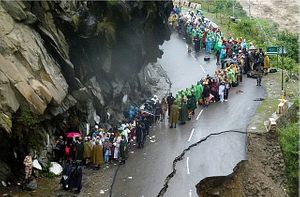Over the past few weeks, this year’s iteration of a major U.S.-led multinational military exercise, the Pacific Partnership, has been playing out, and it will continue its engagements out to June across the Asia-Pacific, including in South and Southeast Asia. At the center of Pacific Partnership is the hospital ship USNS Mercy, with an international team of civilian and military specialists in humanitarian assistance and disaster response. Its mission is to build response capacity in one of the most disaster-prone regions of the world.
Apart from recognizing the significance of this ongoing U.S. led engagement, South Asian nations should also attempt to initiate a similar joint exercise as well.
Why? With today’s divisive politics, nations struggle to predict, prevent, and prepare for disasters. Collaboration increases the likelihood of successful planning and response – and strengthens the foundation for peace in the region.
Military and security professionals increasingly recognize climate change as a threat to national and international security. Extreme weather destroys buildings in minutes, with damage lasting for years. Moreover, climate change exacerbates resource stress, increasing the fragility of already vulnerable populations. Loss of water, food, shelter, power, and jobs can imperil health, force migration and spark conflict or war.
According to reinsurer Munich Re, 2017 was one of the costliest years to date in terms of natural disasters, with total damage estimated at $310 billion.
South Asia bears a disproportionate share of those impacts. Last year climate-induced natural disasters disrupted the lives of 40 million across the region. The Asia Development Bank’s “Region at Risk” report flagged extreme heat, precipitation, sea level rise, cyclones, and receding glaciers as major threats. The floods that devastated India, Nepal, and Bangladesh last August swept away buildings, people, and livestock. Aid agencies report that 30 to 40 percent of those who died were children. An estimated 70 percent of the 400,000 people flooding into Dhaka each year are climate refugees.
Existing conflicts are another hotspot. The stand-off between the Indian and Pakistani armies on the Siachin Glacier, known as the “frozen conflict,” plays out at 18,000 feet — the highest battlefield in the world. Over 33 years it has claimed about 2,400 lives, mostly from avalanches, frostbite, and the complications of living in a hostile environment. Further, tens of thousands of soldiers living at altitude, far from municipal waste treatment systems, has produced tons of chemicals and other pollutants. Melting glaciers are carrying these toxins downstream, threatening the very farmland the soldiers are trying to protect.
Climate change exacerbates the situation. If a poor hillside village becomes dilapidated, the development ministry can help – until severe weather and landslides destroy homes and crush residents. If coastal cities suffer blackouts, the energy ministry can help – until sea level rise or drought compromises the power grid. Then who gets called? The military.
Militaries are the first responders of last resort. When disaster strikes they are on the scene, and quickly too. Military skill and discipline have saved countless lives. But military doctrine and training focus primarily on defense against human aggressors. Climate change requires different strategies: different mission definition, skill sets, equipment, training, and collaboration. If South Asia is to be on the front lines of the climate challenge – as the science suggests it already is – then South Asian militaries must prepare accordingly.
The good news is that they are starting. Defense training in Pakistan now includes coursework on climate security. Officers and parliamentarians analyze the intersection of climate science, diplomacy, and security, and consider courses of action. There are important ramifications for recruitment, doctrine, training, and force planning, as well as trade-offs for planning for traditional and emerging threats.
Sri Lanka’s military has plentiful experience in disaster response. It was the first to respond to the 2015 earthquake in Nepal, which killed nearly 9,000 and injured an additional 22,000. Sri Lanka’s Army chief has recently dedicated 30 percent of the force to disaster response and general capacity building. As one astute observer commented, disaster relief is not a soldier’s job. But only a soldier can do it.
Indeed, South Asian militaries are already “doing it.” Soldiers are assessing where drought and floods could put populations at risk, or exacerbate tensions which spark conflict. Military aircraft must be capable of carrying relief supplies to far-flung locations; remaining aloft in storms; and flying on biofuels. Military meteorologists are tracking fish stocks and flow rates through the international waterways sustaining the region’s 1.5 billion people. It’s a solid start. But the pace must accelerate, in sync with the accelerated pace of extreme weather events.
Success will depend on a whole-of-government approach. The Center for Climate and Security’s Responsibility to Prepare framework argues for the climate-proofing of national, regional, and international security institutions. The responsibility is predicated on using today’s unprecedented foresight to combat today’s unprecedented risks.
Data on where climate extremes are likely to impact security already exist. They are being translated into formats actionable for governments, academia, business, and civil society. The next step is coordinated response. This entails ensuring that local threats are met with local resources: strategic food reserves, backup power, sea walls and other infrastructure. It means pumping political capital into existing regional and international security structures, including the UN Security Council. And it means collaborating on threat analyses, scenarios, and joint early warning and response systems.
Indeed, a report by retired military leaders from India, Pakistan, and Bangladesh – three countries essential to a climate security in South Asia – recommends institutionalizing climate security collaboration as the cornerstone of a long-term strategy for peace and security. Political leaders should heed this wise advice.
In politics, as in climate change, the ultimate aim is to “manage the unavoidable and avoid the unmanageable.” Working together, South Asia can do just that.
Lieutenant General Tariq Waseem Ghazi (Ret) had a 38-year career in the Pakistani Army and served as Pakistan’s Secretary of Defense from 2005-2007.
Rachel Fleishman is a Senior Fellow-Asia Pacific with the Center for Climate and Security, Washington DC.

































